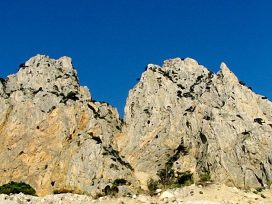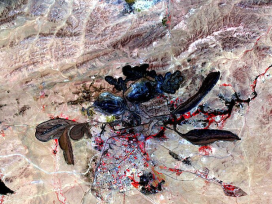Brute force
The climate justice position is necessary but not sufficient for comprehending the current crisis, writes Dipesh Chakrabarty. As a geophysical force, the human species wields a new kind of agency unaccounted for in familiar narratives of the history of capitalist growth.
In order to see why global climate change changes history, we need to think beyond the so-called “climate justice” position. The “climate justice” position is one which holds that the crisis of climate change – I call it a “crisis” for the phenomenon does have the potential to introduce some very long-term and unpleasant changes in human history – is mainly the work of the developed nations, and that they should bear the expenses for mitigating its effect while developing nations, led by China and India, should have the freedom to put economic growth ahead of everything else. In many ways, this is not an unjust claim. There is no question that the per-capita figures for the emission of greenhouse gases (GHG) show that the richer nations have in the past benefited disproportionately from the slack that nature would cut us as we pursued the benefits of industrial and post-industrial civilizations. It surely does not lie in the mouth of the rich to tell the poor to reduce consumption or their emissions of GHG when they themselves should share the bigger part of the blame for leading the world up the historical path that has landed us in our present situation.
This “climate justice” position was elaborated in a United Nations publication called World Economic and Social Survey 2009: Promoting Development and Saving the Planet that was published as part of the preparation for Copenhagen in 2009. The spirit of this document was captured in what Sha Zukung, the UN Under-Secretary General for Economic and Social Affairs, said in his preface: “The climate crisis is the result of the very uneven pattern of economic development that evolved over the past two centuries, which allowed today’s rich countries to attain their current levels of income, in part through not having to account for the environmental damage now threatening the lives and livelihoods of others.” The argument was not that the developing countries should not do their bit for mitigation of the effects of climate change, but that it was mainly the responsibility of the richer nations to pay for cleaning up the mess. The origins of this stance – the talk of “shared but differentiated responsibility” that marked the Kyoto Protocol and all that followed – go back to a booklet published in 1991 by two respected Indian environmentalists: Sunita Narain and the late Anil Agarwal. The very title of their publication revealed the historical stance that was built into their position: global warming was simply yet another instance of western imperialism itself based on an unsustainable pattern of capitalist development. The booklet was called: Global Warming in an Unequal World: A Case of Environmental Colonialism.
Let me put to one side the argument about whether or not capitalism itself can ever be a sustainable system of production of wealth and services for all human beings. But let me say why I find the familiar narrative of western imperialism necessary but not sufficient for the purpose of comprehending the current crisis. It is true that much of the current crisis may be seen as an unintended effect of the kind of industrial civilizations that western nations modeled themselves on and promoted through the world. But the per-capita figures (of GHG emissions) rolled out by the “climate justice” proponents hide a real elephant in the room that few want to acknowledge and discuss: the huge surge in population growth from about the end of the Second World War, and most of this in developing countries. Developed countries have generally seen falling, even negative, rates of population growth. Since population is already a major factor determining total GHG emissions by humanity, and one that puts India and China in the same club as the other polluting nations, we need to think about both the past “polluters” and the past “populators” (if I could coin a word) in accounting for the current crisis and the shapes it may take in the near future. It is clear that the huge leaps in population figures that both India and China have seen since the end of Second World War cannot be blamed on the “logic of capitalism” in any straightforward way.
There are two other reasons why familiar narratives of European or western imperial history, or even simply the history of capitalist growth, while necessary, are no longer sufficient for enabling us to grasp the challenge that the crisis of global warming or climate change poses to our imagination of human pasts and futures. To understand why these narratives are not adequate, we need to turn to another kind of human history: the history that paleoclimatologists write. Their books are no longer, strictly speaking, “natural” history. They write “human” history, a history of global warming from which the question of human agency cannot ever be separated. The latter is indeed the idea we express when we say the present phase of climate change is anthropogenic in nature. This development itself has an element of irony about it. If once intellectuals like Montesquieu taught us to think the climatic variations explained the variations between cultures of humans in different places, many climate scientists are now arguing the reverse: that humans have become the makers of climatic change, that climate in fact depends on us. Collectively, given our technologies and numbers, we, the human species, act on the planet as a geophysical force.
One lesson from paleoclimatologists’ narrative is that in order to deal with human history today, we need to think on scales of time that only natural historians dealt with before. This is so for two reasons. Firstly, one has to know the previous history of this planet’s warming and cooling in order to be reasonably certain that the present warming is anthropogenic. And, secondly, the effects of present climate change – not a one-event phenomenon, rather a cascade of developments – will last for a period that is much longer than what humans usually can care for or imagine. The story is indicated in the subtitle of David Archer’s book The Long Thaw: How Humans are Changing the Next 100,000 Years of Earth’s Climate. This is not a scale of time that we can visualize or (in a hermeneutic sense) understand. This has implications for human history that, as a subject, connects past and futures to the ever-vanishing present precisely through the operation of hermeneutic “understanding”. Historians are not used to dealing with time-scales that we cannot bring imaginatively into the realm of our “experience.”
The second challenge is the way climate scientists visualize the nature of human agency when they say human beings today act like a geophysical force on the planet. Historians and social scientists in general think of human/nature relationship through the images of subjects and objects or, as in environmental history or in many branches of philosophical thinking, they critique and problematize the positing of a subject-object relationship between humans and nature. Besides, historical writing in the last several decades has been profoundly propelled by human ideas about intra-human justice that some now even wish to extend to non-human entities such as plants, animals, rocks, and water-bodies and so on. All this is to some extent based on a critique of the human (subject)/nature (object) division on which so much of European political thought depends. But to say that humans have become a “geophysical force” on this planet is to get out of the subject/object dichotomy altogether. A force is neither a subject nor an object. It is simply the capacity to do things. And force is blind to questions of justice, either between humans or between humans and non-humans. I do not deny the importance, in human terms, of projects of justice; it is impossible to think of a human society in which people have no sense of what is just or unjust. That is why the “climate justice” position is necessary: we cannot avoid it. But the climate crisis may indicate yet another development in our history: that as a geophysical force, we now wield a different kind of agency as well – one that takes us beyond the subject/object dichotomy, beyond all views that see the human as ontologically endowed beings, beyond questions of justice and human experience. To incorporate this agency into our telling of the human story, we will need to develop multiple-track narratives so that the story of the ontologically-endowed, justice-driven human can be told alongside the other agency that we also are – a species that has now acquired the potency of a geophysical force, and thus is blind, at this level, to its own perennial concerns with justice that otherwise forms the staple of humanist narratives.
Published 7 October 2010
Original in English
First published by IWM Post Autumn 2010
© Dipesh Chakrabarty / IWM / Eurozine
PDF/PRINTIn collaboration with
Newsletter
Subscribe to know what’s worth thinking about.
Related Articles

To have a body
Esprit 3/2025
Esprit revisits the philosophy of Maurice Merleau-Ponty: including Guillaume Le Blanc on ‘incarnation’; Corine Pelluchon on eco-phenomenology; and Judith Revel on Merleau-Ponty, ‘the eternal runner-up’.

Europe produces 5 tons of waste per capita each year and exports a significant portion of it for other countries to handle. Can we reduce, reuse, and recycle our way out of this? New talk show episode premiers today.





